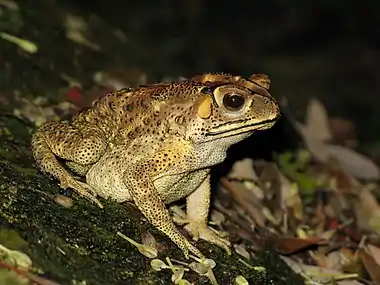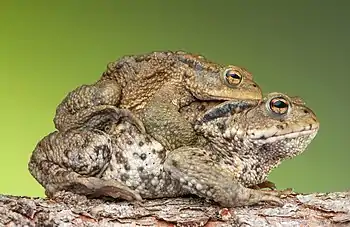Portal:Amphibians
The Amphibian Portal
 |
.png.webp)
Amphibians are four-limbed and ectothermic vertebrates of the class Amphibia. All living amphibians belong to the group Lissamphibia. They inhabit a wide variety of habitats, with most species living within terrestrial, fossorial, arboreal or freshwater aquatic ecosystems. Thus amphibians typically start out as larvae living in water, but some species have developed behavioural adaptations to bypass this.
The young generally undergo metamorphosis from larva with gills to an adult air-breathing form with lungs. Amphibians use their skin as a secondary respiratory surface and some small terrestrial salamanders and frogs lack lungs and rely entirely on their skin. They are superficially similar to reptiles like lizards but, along with mammals and birds, reptiles are amniotes and do not require water bodies in which to breed. With their complex reproductive needs and permeable skins, amphibians are often ecological indicators; in recent decades there has been a dramatic decline in amphibian populations for many species around the globe.
The earliest amphibians evolved in the Devonian period from sarcopterygian fish with lungs and bony-limbed fins, features that were helpful in adapting to dry land. They diversified and became dominant during the Carboniferous and Permian periods, but were later displaced by reptiles and other vertebrates. The origin of modern amphibians belonging to Lissamphibia, which first appeared during the Early Triassic, around 250 million years ago, has long been contentious. However the emerging consensus is that they likely originated from temnospondyls, the most diverse group of prehistoric amphibians, during the Permian period. (Full article...)
Selected frog article
The Seychelles palm frog (Sechellophryne pipilodryas) is a species of frog that is endemic to Silhouette Island in the Seychelles. It is closely related to Gardiner's frog, Sechellophryne gardineri.
The Seychelles palm frog inhabits forests higher than 150 m (490 ft) above sea level and is closely associated with the palm Phoenicophorium borsigianum (another Seychelles endemic); most individuals are found in axils of the palm. It is the most arboreal of the Sooglossidae. As a result, the palm frog is the most recent species of the family to have been discovered (in 2000).
The reproductive biology of this species is unknown, but it is presumed to involve direct development, i.e. eggs that hatch directly into froglets. (Full article...)Selected salamander article
 |
Sirenidae, the sirens, are a family of neotenic aquatic salamanders. Family members have very small fore limbs and lack hind limbs altogether. In one species, the skeleton in their fore limbs is made of only cartilage. In contrast to most other salamanders, they have external gills bunched together on the neck in both larval and adult states. Sirens are found only in the Southeastern United States and northern Mexico.
Although they are primarily carnivorous, they are the only salamanders observed eating plant material. (Full article...)List of selected salamander articles |
|---|
Did you know? –

- ... that Gerobatrachus is considered to be a missing link that supports the hypothesis offered by cladistics, that frogs and salamanders had a common ancestor?
- ... that the call made by Limnodynastes dorsalis, a frog species in Western Australia, is similar to the sound of a plucked banjo string?
- ... that the Blanchard's cricket frog (pictured) is considered threatened or endangered in three states, but is not listed under the US Endangered Species Act?
- ... that the male frog Allobates femoralis (pictured) carries his tadpoles to pools of water?
Selected amphibian type
.jpg.webp) |
Caecilians (New Latin for 'blind ones') (/sɪˈsɪliən/) are a group of limbless, vermiform (worm-shaped) or serpentine (snake-shaped) amphibians. They mostly live hidden in soil or in streambeds, and this cryptic lifestyle renders caecilians among the least familiar amphibians. Modern caecilians live in the tropics of South and Central America, Africa, and southern Asia. Caecilians feed on small subterranean creatures such as earthworms. The body is cylindrical and often darkly coloured, and the skull is bullet-shaped and strongly built. Caecilian heads have several unique adaptations, including fused cranial and jaw bones, a two-part system of jaw muscles, and a chemosensory tentacle in front of the eye. The skin is slimy and bears ringlike markings or grooves, which may contain tiny scales.
Modern caecilians are grouped as a clade, Apoda /ˈæpədə/, one of three living amphibian groups alongside Anura (frogs) and Urodela (salamanders). Apoda is a crown group, encompassing modern, entirely limbless caecilians. There are more than 200 living species of caecilian distributed across 10 families. The caecilian total group is an order known as Gymnophiona /dʒɪmnəˈfaɪənə/, which includes Apoda as well as a few extinct stem-group caecilians (amphibians related to modern caecilians but evolving prior to the crown group). Gymnophiona as a name derives from the Greek words γυμνος / gymnos (Ancient Greek for 'naked') and οφις / ophis (Ancient Greek for 'snake'), as the caecilians were originally thought to be related to snakes.
The study of caecilian evolution is complicated by their poor fossil record and specialized anatomy. Genetic evidence and some anatomical details (such as pedicellate teeth) support the idea that frogs, salamanders, and caecilians (collectively known as lissamphibians) are each others' closest relatives. Frogs and salamanders show many similarities to dissorophoids, a group of extinct amphibians in the order Temnospondyli. Caecilians are more controversial; many studies extend dissorophoid ancestry to caecilians. Some studies have instead argued that caecilians descend from extinct lepospondyl or stereospondyl amphibians, contradicting evidence for lissamphibian monophyly (common ancestry). Rare fossils of early gymnophionans such as Eocaecilia and Funcusvermis have helped to test the various conflicting hypotheses for the relationships between caecilians and other living and extinct amphibians. (Full article...)List of selected amphibian type articles |
|---|
Selected images
Selected toad article
 Woodhouse's toad (Anaxyrus woodhousii) |
Selected caecilian article
Need help?
Do you have a question about Amphibians that you can't find the answer to?
Consider asking it at the Wikipedia reference desk.
Topics
Subcategories
Related portals
Associated Wikimedia
The following Wikimedia Foundation sister projects provide more on this subject:
-
 Commons
Commons
Free media repository -
 Wikibooks
Wikibooks
Free textbooks and manuals -
 Wikidata
Wikidata
Free knowledge base -
 Wikinews
Wikinews
Free-content news -
 Wikiquote
Wikiquote
Collection of quotations -
 Wikisource
Wikisource
Free-content library -
 Wikiversity
Wikiversity
Free learning tools -
 Wiktionary
Wiktionary
Dictionary and thesaurus
-
 List of all portalsList of all portals
List of all portalsList of all portals -
 The arts portal
The arts portal -
 Biography portal
Biography portal -
 Current events portal
Current events portal -
 Geography portal
Geography portal -
 History portal
History portal -
 Mathematics portal
Mathematics portal -
 Science portal
Science portal -
 Society portal
Society portal -
 Technology portal
Technology portal -
 Random portalRandom portal
Random portalRandom portal -
 WikiProject PortalsWikiProject Portals
WikiProject PortalsWikiProject Portals





_jeannaea.jpg.webp)






.jpg.webp)
_Ranomafana.jpg.webp)
